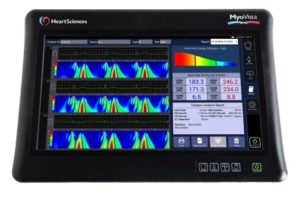
A medical device company has announced the results of a clinical study serially conducted at The Icahn School of Medicine, Mount Sinai Hospital, New York, USA and the West Virginia University (WVU) Heart and Vascular Institute, Morgantown, USA. The results will be published in the April 17, 2018 issue of Journal of the American College of Cardiology (JACC), a peer-reviewed journal in cardiovascular medicine.
The article titled “Prediction of Abnormal Myocardial Relaxation from Signal Processed Surface ECG” presents the results from the investigator-initiated clinical study that focused on evaluating the feasibility of MyoVista Wavelet ECG (wavECG) as a diagnostic tool for predicting myocardial relaxation abnormalities. Abnormal relaxation is an early feature of many types of heart disease and a key characteristic of left ventricular diastolic dysfunction (LVDD). It is typically detected using echocardiographic imaging. LVDD is a strong predictor of cardiovascular and all-cause mortality.1 Ischemia, hypertension, diabetes, valvular disease and reduced systolic function are all associated with LVDD.1, 2
Results from the feasibility study demonstrate MyoVista patented technology can detect myocardial relaxation abnormalities associated with LVDD. The study results demonstrated 80% sensitivity and 84% specificity with an area under the curve of 91% for the prediction of low (e’), an echocardiographic parameter widely used in determination of LVDD. Prediction of low (e’) also correctly identified 23 out of 28 study subjects (82%) with significant underlying coronary artery disease. Additionally, MyoVista wavECG prediction of relaxation abnormalities also allowed recognition of subjects with more advanced stages of DD and concurrent CAD with significantly more incremental value compared with clinical variables and conventional ECG information. The feasibility study was performed using machine learning analysis often described as artificial intelligence or AI. The study included a limited number of patients as well as other limitations and future studies were recommended to address these limitations.
Conclusions of the trial suggest a potential role for the MyoVista wavECG Device as a screening tool for patients at risk for LVDD that would benefit from echocardiographic evaluations.
Partho Sengupta, Professor, Chief of Cardiology and Chair of Cardiac Innovation, WVU Heart & Vascular Institute and Principal Investigator in the study, commented, “These data are extremely encouraging as they suggest a potential role of signal processed ECG in early cardiac disease detection. It is quite remarkable that MyoVista demonstrated a high diagnostic precision in detecting a state of cardiac muscle dysfunction only previously detectable using cardiac ultrasound techniques. This can eventually help in appropriate cardiac testing and reduce overall healthcare costs.”
A total of 188 subjects referred from outpatient clinics to the Icahn School of Medicine, Mount Sinai Hospital for coronary computed tomography (CT) angiography also undertook in the same visit, comprehensive two-dimensional echocardiography (including tissue Doppler) that included assessment of LVDD. Subjects with arrhythmias, unstable angina, previous cardiac surgery, a pacemaker, chest deformity, or an inability to express well-defined mitral annular velocities due to severe mitral annular calcifications were excluded. Additional analysis was conducted related to a comparison cohort that were evaluated at WVU, Heart and Vascular Institute which further validated MyoVista wavECG healthy patient characteristics as well as age and population distribution information.
References
- LV Diastolic Dysfunction and Prognosis, Dalane W. Kitzman, et al., Circulation, 2012 February 14: 125(6): 743-745. doi:10.1161.CIRCULATIONAHA.111.086843
- Diastolic Dysfunction and Diastolic Heart Failure: Diagnostic, Prognostic and Therapeutic Aspects, Maurizio Galderisi, Cardiovascular Ultrasound, 2005, 3-9 doi:10.1186/1476-7120-3-9










